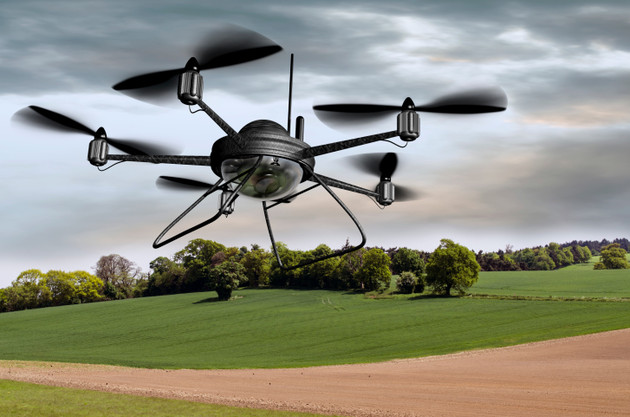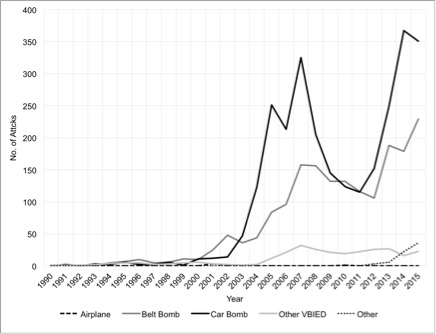By: Scott N. Romaniuk, Tobias J. Burgers
 Over the past four decades, suicide attacks has become the weapon of choice for terrorist organizations from the Liberation Tigers of Tamil Eelam (LTTE) to the Islamist fundamentalists of Islamic State (IS). However, with the advent of consumer drone use by terrorists groups in the Middle East – which has risen significantly in the past year, particularly on the part of IS militants – that may now be on the brink of changing.
Over the past four decades, suicide attacks has become the weapon of choice for terrorist organizations from the Liberation Tigers of Tamil Eelam (LTTE) to the Islamist fundamentalists of Islamic State (IS). However, with the advent of consumer drone use by terrorists groups in the Middle East – which has risen significantly in the past year, particularly on the part of IS militants – that may now be on the brink of changing.
Data collected by the Chicago Project on Security & Terrorism (CPOST) on suicide attacks over the past 40 years shows how more than 100 militant groups have experimented with and adapted this form of assault. The data shows how, at different times, different methods have found favor among terrorist groups. Crucially, it also demonstrates a willingness by militant groups to experiment. [1]
Adaptation and Experimentation
Suicide attacks have been undertaken by individuals using various types of devices and methods of delivery. Some examples include wearable devices such as belt bombs, car bombs and other vehicle-borne IEDs (VBIEDs) and explosive devices taken on board airplanes.
 The use of car bombs spiked in 2004 (see chart) after the U.S. invasion of Iraq, and was followed to a lesser degree by an increase in the use of other VBIEDs and “unspecified” forms of suicide attack, as militants explored other newer and possibly more efficient forms of attack.
The use of car bombs spiked in 2004 (see chart) after the U.S. invasion of Iraq, and was followed to a lesser degree by an increase in the use of other VBIEDs and “unspecified” forms of suicide attack, as militants explored other newer and possibly more efficient forms of attack.
Source: CPOST, Suicide Attack Database
Chart: Statistics of Suicide Attacks by Weapon Type (1990-2015)
Now that experimentation is taking a different form. On October 2, 2016, IS militants flew a small, unmanned aerial vehicle (UAV) affixed with an IED on an attack mission, killing two Kurdish Peshmerga fighters and wounding two French paratroopers (Haaretz, October 13, 2016).
The incident may have been the first successful terrorist UAV-IED attack, but militant groups have been exploring the potential of drones for years. As early as 2001, al-Qaeda deliberated over using a remotely operated aerial explosive device against G8 Summit leaders in Genoa, Italy. The group also planned to attack the British House of Commons with an anthrax-filled drone, with an additional plot to attack commercial aircraft using remote-controlled planes with explosives attached to them (Center for Arms Control, 2005).
During the 2006 war between Israel and Hezbollah, the latter sought to bomb Israeli territory by deploying explosive-laden UAVs. Hezbollah’s plans played-out unsuccessfully, but the group saw some success in 2016 when it bombed opposing forces in the Syrian war using UAVs loaded with hand grenades.
Jund al-Aqsa’s use of a drone during the summer of 2016 to deliver a small bomb on the Syrian battlefield in Hama province is also indicative of the prospects and likelihood of future terrorist drone attacks (New Arab, October 12, 2016). And in late 2016, the Taliban used a drone to film a suicide car-bomb attack on a police station in Nawa-i-Barakzayi, in Afghanistan’s Helmand province.
A New Security Paradigm
The unchecked proliferation of unmanned systems and their use by state and non-state actors makes it likely there will be increased use of unmanned systems by militant groups to launch attacks over the next decade. IS has already successfully demonstrated, albeit to a limited extent, that the merger of increasingly accessible drone technology with IEDs can be used to carry out attacks.
Taking things a step further, miniature unmanned systems could present even greater security challenges. These systems are already hard to detect and, if analysts’ predictions are accurate, they will be as small as a fly or ladybug in under a decade. While tiny in size, miniature unmanned systems will be able to carry a payload sufficient for an attack on a human target (Defense One, May 28, 2015).
They may be sufficient to carry out an assassination, or to kill groups of people in an attack on, for example, a football stadium. Pilot Mark Jacobsen offered a chilling illustration of this when, with about $250, he built a UAV-IED capable of delivering a two-pound load, somewhere between 6-12 miles – not nearly as lethal as an F-16 strike, but enough for a deadly attack against a civilian target (WOTR, October 19, 2016). Moderately larger devices could be used to attack commercial planes, ships and other targets.
The situation is of particular concern when one considers how easily al-Qaeda has been able to disseminate advice on tactics via online media. Its online magazine Inspire, popularizes target types, modes of attack and attempts to empower people of all walks of life to take-up-arms against the United States. Another magazine, al-Shamika, has similarly helped to expand the margins of attacks (Al-Arabiya, August 23, 2016).
The use of UAVs is a natural development of the kind of DIY approach to terrorism that groups like al-Qaeda and IS have been practicing for years, to say nothing of the efforts of IS and others to recruit on college campuses and enlist individuals in the fields of engineering, organic chemistry and nanotechnology (Carnegie, June 29, 2015). It may become necessary to look beyond measures that involve merely shooting down a terrorist drone or UAV-IED, especially where its payload may not be solely explosive-based but might contain enriched material or other toxic substance.
Tackling the Drone Threat
The U.S. government faces the problem of groups like IS and al-Qaeda using UAVs on two broad fronts. First, there is the threat posed to U.S. military personnel, as well as the military personnel of coalition forces deployed. Second, and more disconcertingly, there is the threat posed to civilian populations. Defending civilian populations against flying IEDs will not be as easy as defending U.S. soldiers on deployment.
In 2015, Congress requested $20 million to provide U.S. military personnel with the necessary equipment to contend with flying IEDS. Part of that equipment includes the Batelle DroneDefender, or directed-energy unmanned aircraft system countermeasure (Defense One, January 3, 2017). The battery-operated device, known as an “anti-drone rifle” and designed much like a regular assault rifle, is an innovative system capable of instantly disrupting small aerial vehicles like those being used by IS.
Companies such as Boeing and Lockheed Martin are also testing an array of new laser systems that have had some success in shooting down smaller UAVs. These are relatively inexpensive to produce and could be a major inroad into counter-drone measures.
At present, response options remain extremely limited, but such systems are precisely where research and developed are needed.
No comments:
Post a Comment